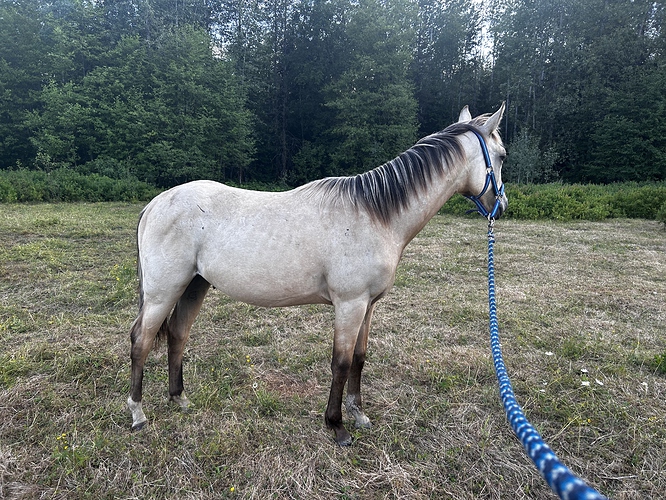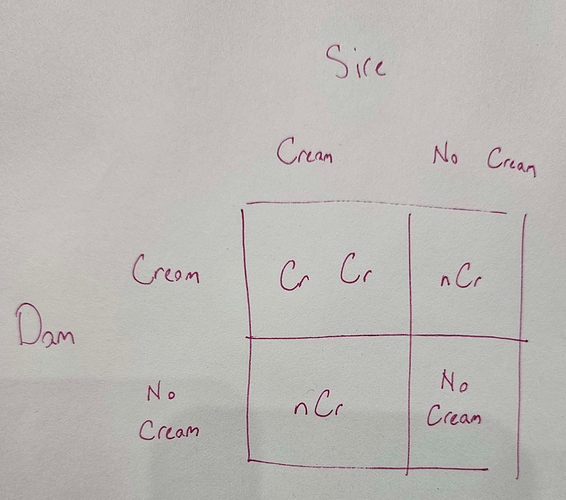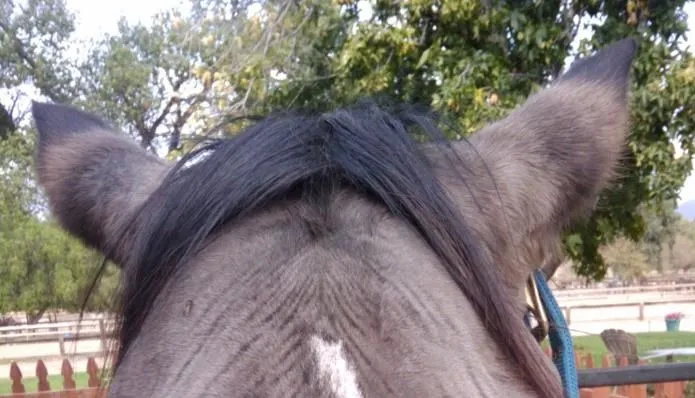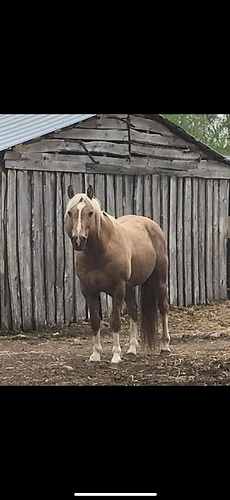I have a 2yo buckskin? bay dun? gelding. I have no clue how to figure out what he is. He does not have a dorsal stripe, his mane is black/blonde and his “black points” are not true black points. I’ve tried endless research but cannot find out what he could be. I have attached a pic of him! Mom is a buckskin and dad is a chocolate palomino.
You have a buckskin with frosting (which is the white along the edges of his mane). He can’t be a dun without a dun parent. Since he is only a 2 year old, the black on his legs will likely fill in more as he ages.
Buckskin. Have heard them called buttermilk buckskins with all that frosting.
There are different variants of dun dilute and not all have the really vivid dorsal stripe. You’d need to get a UCDavis genetic color test, but my guess is you have bay + creme dilute + dun. Yes commonly called buttermilk buckskin.
It’s a really pretty color, but not a super rare one if you are around breeds with lots of dilutes
Gorgeous horse! What is his breed?
Agree on buckskin, no dun. A prominent dorsal stripe is a requirement, and it’s only really not terribly visible on the double dilutes, and obviously white markings, and gray, will cover/remove it
Thank you!!! He is a registered quarter horse!
Treat yourself! You can get DNA testing done which will tell you the color. I used Etalon for my Paint gelding. He was a sorrel sabino but did not have the sabino gete. They have a variety of health profiles, including HYPP. I also had ancestry done, which is fun with QH and Paints because they are a hodge-podge of breeds from all over the world. I also got some perfomance info. My horse had Man o’ War in his pedigree, and he was built like a TB, but his speed was “Sprint” vs. “Endurance” which means 6-8 furlongs was about all he had in him. He also was Curious whcih was absolutely true. The other option is vigilant.
UC Davis also does color testing.
He’s beautiful and I love his halter and lead rope.
Cute horse and what a color!
Question:
If the dam is buckskin and the sire is sooty palomino why wouldn’t he be perlino?
What am I missing?
Thanks
I made a mistake!! his dad is NOT a sooty palomino, he looks to be a chocolate palomino
You have a chance at perlino, but it isn’t guaranteed.
Buckskin = Bay + 1 cream gene (genotype: E_/ A_/ nCr)
Sooty Palomino = Chestnut + 1 cream gene + 1-2 sooty (genotype: ee / _ _ / nCr / nSty or StySty). No idea if he is an AA, Aa, or aa without testing.
You could wind up with all three base coats from that (Black = E_ aa, Chestnut = ee Aa, ee AA, or ee aa, Bay = E_ A_). Each parent can pass on the cream, but they both could just happen not to. The sire has a 50% shot of passing on the sooty if he only has one copy (edit: stallion doesn’t have sooty so moot point).
Options are
- 25% double dilute (Perlino, Cremello, or Smokey Cream)
- 50% single dilute (Buckskin, Palomino, or Smokey Black)
- 25% no dilute (Bay, Chestnut, or Black)
Chocolate palominos are very pretty. But with that, your boy is most likely a plain buckskin with frosting since neither parent carries dun. My barn actually has two horses who look identical, except one is a buckskin and the other a dunskin/bay dun (we don’t know if he actually has a cream gene or if he’s just a very buttermilky dun). They’re the same color as your boy. Some buckskins have frosting and some duns don’t.
A dun would show some part of the dun pattern: dorsal stripe, leg striping, shoulder barring, neck shadowing, cobwebbing/mottling on the face, dark ear tips, etc. The dark points on a dun’s ears aren’t around the edge, but the tip itself.
FWIW, they have gotten it wrong on some very basic tests, so they aren’t a lab I trust at all, for anything. UC Davis and Animal Genetics are much more reliable
Because each parent only has a 50/50 chance of passing on cream, and perlino would require that both of them did. Cream x Cream = 25% non-cream, 25% double cream, and 50% single cream
chocolate palomino isn’t a thing. They’re either simply a darker shade, just like there’s a whole range of shades of chestnuts, or he has sooty which has darkened him a bit. A picture would tell a better story, as sooty typically also starts darkening the mane and tail
The only real requirement is the dorsal stripe, assuming the color/pattern allow it to be visible enough. I don’t remember if the ear tips are also required, but at the very least they are (nearly) always present
Sooty can mimic some Dun factors, and nd1 can do a good job at that as well, even producing all those factors, but without a strong Dun coat dilution (it can dilute a bit, especially if homozygous)
Another for Buckskin! No dorsal stripe. Like a Dun they can really vary in range of color.
Duns/ Grullo always have a dorsal stripe and usually some kind of barring on legs or face or shoulder area …
Picture of sire. He’s advertised as a chocolate palomino, but to me he doesn’t look as dark as a “chocolate palomino” or “sooty palomino”. I’m not super knowledgeable on the colour genetics, still trying to gather knowledge here and there.
Yeah, that’s definitely not even the “chocolate” phenotype. It’s called “chocolate” for a reason lol
He does have the look of sooty, especially if his tail is as dark as this pic makes it look, very classic sooty progression
Is chocolate palomino really silver dapple modifier on bay?
He has no dun factor, no primitive markings, and none of the peachy shade that comes with dun. One thing duns usually have more than any other primitive markings is the dun strip that goes right though their tail and doesn’t stop at the base of the tail. Why do you think he is what is commonly called a dunskin? A buttermilk buckskin is a very light shade of buckskin without dun.
people have used chocolate to (incorrectly) describe both the heavily sooty and/or dark palomino, and the silver dapple. Silver only affects black- and bay-based colors, to a larger (obvious) or smaller (can barely tell unless you know what you’re looking for) degree, which varies largely by breed (ie QH’s are notorious for not looking very Silver), and even lines.




